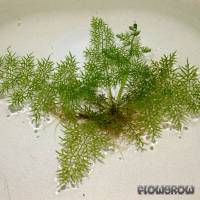



Ceratopteris thalictroides is an amphibic fern found in many tropical regions of the world in shallow waters and on muddy ground, amongst others in rice paddies. In some tropical regions of Asia the emersed leaves of this species are used as vegetable. In nature, this plant is said to be an annual plant, however, it can be cultivated over several years without problems. The species contains many local forms, and in aquaristics, varietys with more coarsely or finely pinnate submersed leaves are common (photos 1 to 3 show an especially delicate form of C. thalictroides). The species has been known in the hobby for many years, also under the synonym of Ceratopteris siliquosa as well as under the vernacular names of water sprite, Indian fern, Oriental waterfern and water hornfern.
Botanists disagree whether Ceratopteris cornuta, originating from Africa, is to be considered a species of its own or a synonym of C. thalictroides. In aquaristics, those plants with coarser lobes/leaflets are generally called C. cornuta, and those with finer leaflets are known as C. thalictroides. It is not clear, however, if those coarser-looking plants are truly C. cornuta or simply a variety of C. thalictroides (in the narrower sense). A third species, Ceratopteris richardii, can only be discerned from C. thalictroides and C. cornuta by the number of spores per sporangium. Moreover, Ceratopteris species are known to hybridise.
C. thalictroides is a very fast growing fern and is usually cultivated free-floating on the water surface, like all other Ceratopteris species. Labyrinth fish gladly accept it for building their bubble nests, and it provides fish fry with great places to hide. However, when planted into the ground it grows even better as a submersed plant. C. thalictroides forms large, fine-leaved, light green bushes within a short time, and as it requires a lot of space it is best cultivated in large tanks as solitary plant. Its requirements are not difficult to meet; medium light intensities and CO2 concentrations of under 20 mg/l are sufficient, however, the fern will grow better under intensive light, with additional CO2 and nutrient-rich water.
It forms plantlets in the grooves between the lobes of older leaves, like other Ceratopteris species, however, in lower numbers. In order to further the development of these plantlets it is recommended to sever the older leaves from the plant and let them float on the surface.
In shallow water and on wet substrates rich in nutrients, C. thalictroides forms emersed leaves, which are finely pinnate, too. Spore-carrying fronds have very narrow leaf tips. Their margins are rolled in towards the underside and thus cover the sporangia (spore capsules).
<a href="https://www.flowgrow.de/db/aquaticplants/ceratopteris-thalictroides" target="_blank"><img alt="Ceratopteris thalictroides" title="Ceratopteris thalictroides" src="https://www.flowgrow.de/db/widget/aquaticplants/ceratopteris-thalictroides" /></a>
[url=https://www.flowgrow.de/db/aquaticplants/ceratopteris-thalictroides][img]https://www.flowgrow.de/db/widget/aquaticplants/ceratopteris-thalictroides[/img][/url]
[widget=aquaticplants/ceratopteris-thalictroides]Ceratopteris thalictroides[/widget]